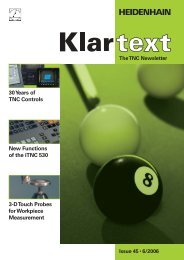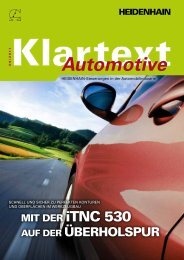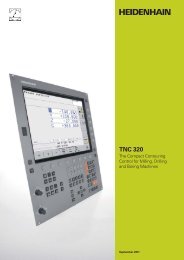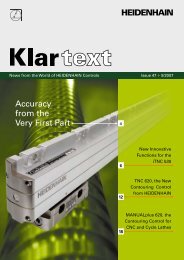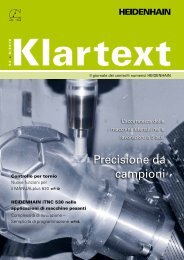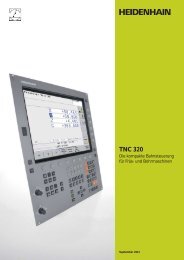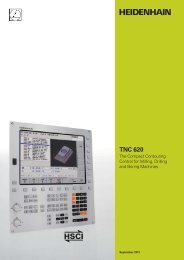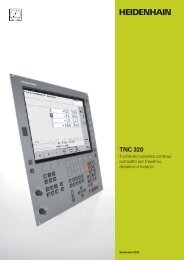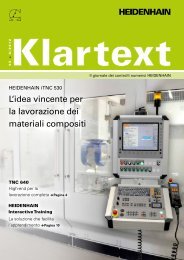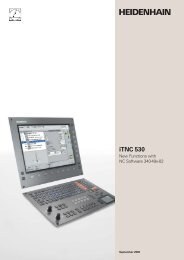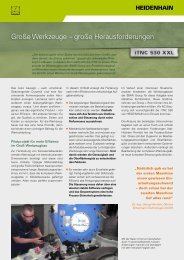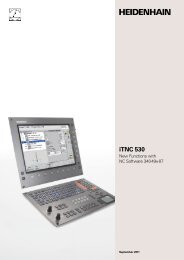iTNC 530 - TNC 640 - DR. JOHANNES HEIDENHAIN GmbH
iTNC 530 - TNC 640 - DR. JOHANNES HEIDENHAIN GmbH
iTNC 530 - TNC 640 - DR. JOHANNES HEIDENHAIN GmbH
Create successful ePaper yourself
Turn your PDF publications into a flip-book with our unique Google optimized e-Paper software.
Machining with Five Axes<br />
– The <strong>i<strong>TNC</strong></strong> <strong>530</strong> Permits Optimum Tool Movement<br />
Modern machines often work with four or<br />
fi ve positioning axes. This makes it possible<br />
to machine complex 3-D contours. The<br />
required programs are usually created on<br />
external CAM systems and comprise a<br />
large number of very short line segments<br />
that are transferred to the control. Whether<br />
the workpiece is actually machined<br />
according the program’s instructions<br />
depends essentially on the geometric<br />
behavior of the control. With its optimized<br />
path control, its precalculation of the<br />
contour and its algorithms for jerk<br />
limitation, the <strong>i<strong>TNC</strong></strong> <strong>530</strong> has the right<br />
functions for a perfect surface in the<br />
shortest possible machining time. See for<br />
yourself. In the end, it’s the quality of the<br />
workpiece that proves the performance of<br />
the control.<br />
10<br />
3-D contour machining at its fi nest<br />
The <strong>i<strong>TNC</strong></strong> <strong>530</strong>’s short block processing<br />
time of only 0.5 ms for a 3-D line segment<br />
without tool compensation permits high<br />
traversing speeds even on complex<br />
contours. This enables you, for example,<br />
to mill molds or dies approximated with<br />
0.2 mm line segments at feed rates as<br />
high as 24 meters per minute.<br />
The particularly jerk-free path control<br />
when machining 3-D fi gures and the<br />
defi ned rounding of series of straight-line<br />
segments provide you with smoother<br />
surfaces as well as high dimensional<br />
accuracy.<br />
The <strong>i<strong>TNC</strong></strong> <strong>530</strong> thinks ahead. Its “lookahead”<br />
function anticipates future changes<br />
in direction by adjusting the traversing<br />
speed to the programmed surface. If<br />
desired, it also enables the <strong>i<strong>TNC</strong></strong> <strong>530</strong> to<br />
reduce the feed rate when plunging the<br />
tool into the workpiece. This lets you<br />
simply program the maximum machining<br />
speed as the feed rate. The <strong>i<strong>TNC</strong></strong> <strong>530</strong><br />
automatically adapts the actual speed of<br />
the workpiece contour to save you<br />
machining time.<br />
For NC programs with normal vectors,<br />
such as those generated by CAM systems,<br />
the <strong>i<strong>TNC</strong></strong> <strong>530</strong> automatically calculates a 3-D<br />
tool compensation for end mills, ball-nose<br />
cutters, or toroid cutters.



